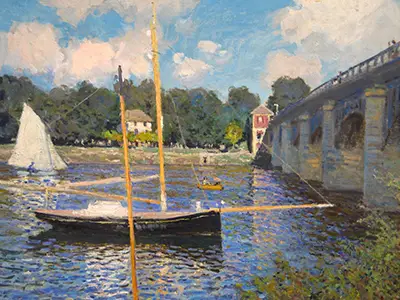In 1872, after travelling around London to work and sight see, Monet returned to his native France. He pretty much made straight for Argenteuil where he painted some of his most beloved works of art.
The Impressionist artist Claude Monet spent time at work in various locations throughout Europe. He was especially devoted to the French countryside, but at the turn of the 20th century, and in the mid 19th century, he famously spent time in London painting key London landscapes such as the Houses of Parliament. One of Monet's most fruitful working periods was the time that he spent in Argenteuil.
One of the most famous paintings that he painted during his time in Argenteuil was quite simply called Argenteuil. He painted this work in 1875. Argenteuil depicts the mirror like waters of the Argenteuil waterways, covered in parts with lurid green algae, and supporting rusted boats.
Boats were one of Monet's favourite things to draw and paint, indeed one of he earliest professional drawings that he produced at the age of 17 depicted a harbour at Dieppe with a ship veering into the foreground. He also continued to produce studies of boats using pencil and paper, and in the form of completed paintings, throughout his career.
What is notable about his painting entitled Argenteuil is the rust red colour of the boats, particularly when set against the greens and blues of the water.
Impressionists like Monet liked to work in a style that was called 'en plein aire' - this basically meant working outdoors, in the open air. Usually Monet would simply work to the location that he would be painting at with his portable easel, unfold it and then stand on an elevated or flat patch of ground to complete his works of art. During his stay in Argenteuil, however, Monet pioneered a slightly different method of working for any of his paintings.
He was fascinated, whilst he stayed in Argenteuil, by the effects of sunlight and the water and by the figures of the looming boats made colourful with rust and use. As a result, he wanted to get as close as possible to what he was painting, putting himself in the midst of the landscape.
He used a boat of his own to sail out into the water with his easel so that he could get the desired angles for his paintings, and not simply paint whilst limited to a certain viewpoint as he would have been had he stayed on the banks of the water and painted the boats at a greater distance from dry land.
Monet was not alone in Argenteuil. Rather, he was part of a group of artists who were all painting and inspiring each other. For most of his stay in Argenteuil, Monet was joined by Pierre-Auguste Renoir, Alfred Sisley, and Édouard Manet, and this group of artists were all producing some of their best work out in this Parisian suburb.
Art historians tend to describe these other artists as heading to Argenteuil because they were attracted by the presence of Monet, rather than the other way around. Sisley was the first painter to visit Monet at Argenteuil. A contemporary of Money, Sisley was known for his Impressionist landscape paintings. He was a British citizen, though he was actually born in France and spent most of his life there, inspired, as Monet was, by the unique French countryside.
Clearly the atmosphere was right for some serious painting to be done. Monet certainly produced a large number of paintings whilst at Argenteuil. This was characteristic of him - when he was at London, for example, John Singer Sargent noted that Monet would often be working on as many as 80 canvases simultaneously. Other works that Monet created whilst in Argenteuil included 'Autumn Effect at Argenteuil' and 'The Bridge at Argenteuil'.
The former painting depicts a tranquil, dreamy stretch of water with a mystical edifice at the end. On either side of the water orange and ochre coloured trees can be seen - this is definitely an autumn scene.
What is immediately eye catching about Autumn Effect at Argenteuil is its use of perspective, with the river running right down the centre of the painting and leading the viewer's eye up to the building at the end. This work is currently held in London in the Courtauld Gallery on the Strand.
Now, let us turn to The Bridge at Argenteuil (or in its original French, Le Pont d'Argenteuil). Painted in 1874, the creation of this work coincided with the first ever exhibition of Impressionist art works per se.
The Bridge at Argenteuil shows a subject that Monet kept on coming back do during the time that he spent in Argenteuil: the Argenteuil bridge and the way that the sunlight played both on the edifice of the bridge itself and on the water beneath it. Carefully drawn boats also feature in this painting, as they did in so many of Monet's Argenteuil art works.
To summarise Monet's stay in Argenteuil, we can say that this was a period of intense activity, and of being inspired both by the unique landscapes of Argenteuil and by the company of like minded artists around him. In Argenteuil, Monet also came back to some of his favourite topics for paintings: bridges, boats, and light. The style used in impressionism, when compared to famous Renaissance paintings such as Michelangelo's Last Judgement, Da Vinci's Annunciation and Caravaggio's Supper at Emmaus underline just how much art developed over the centuries that past between them.
Monet's stay at Argenteuil coincided with the first Impressionist art exhibition and the moment when (in 1874) as a result of this exhibition the words 'Impressionism' and 'Impressionist' entered the vocabulary of art critics and the general public for the first time.
All in all, then, Monet's time spent in the suburb of Argenteuil was one that was extremely important for his career as a whole.


